Menu
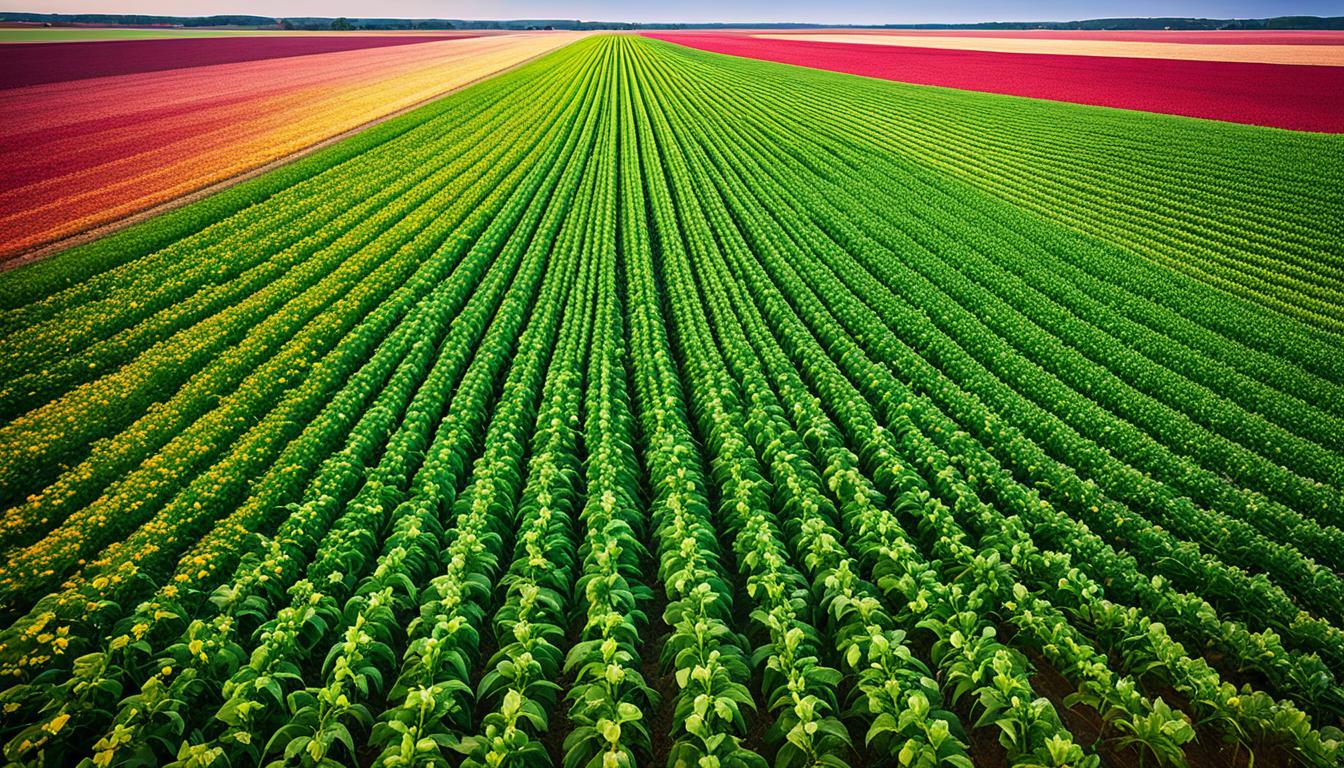
By 2012, a big part of the corn (88%), cotton (94%), and soybeans (93%) planted in the United States were biotech crops. This shows how much agricultural biotechnology has changed farming. Now, the world is seeing more biotech crops being grown. This is because they offer food systems that are more sustainable and resilient.
Developing biotech crops uses the latest biological methods to grow more and help the environment. These methods play a big role in meeting the global need for food while protecting the planet. Let’s take, for instance, the Philippines. There, sharing info about biotech crops and animal tech is helping to make sustainable food systems.
Biotech crop development uses biological methods to boost crop yields and help in farming sustainably. It meets the world’s food needs, reducing harm to our planet. We’ll look into what sustainable agriculture means and the critical part biotechnology has in it.
Sustainable agriculture aims to feed us now while keeping the earth healthy for our kids. It looks at making money, looking after nature, and taking care of people. It’s about using natural resources wisely, making a profit, and ensuring that farmers and their communities do well.
Biotechnology is essential in farming, offering ways to grow more food, resist pests and diseases, and add nutrients. For instance, genetically modified (GM) insect-resistant cotton cuts down on harmful pesticides. This is good for our water and environment. GM crops like soybeans, cotton, and corn that can withstand herbicides help in controlling weeds and protecting the soil.
Biotech crop development has helped a lot in farming sustainably. In the Philippines, the 19th National Biotechnology Week showcased these modernisations. They show how such solutions can lead to a more sustainable future. Farmers can benefit from better earnings, improved crop quality, easier work, and safer practices thanks to these innovations. It shows how crucial agri-biotech solutions are for facing the challenges of today and tomorrow.
| Crop | Biotechnology Adoption Rate (2012) | Environmental Benefits |
|---|---|---|
| Corn | 88% | Improved insect resistance, reduced pesticide use |
| Cotton | 94% | Reduced pesticide applications, groundwater protection |
| Soybeans | 93% | Enhanced herbicide tolerance, topsoil preservation |
Biotech makes changing genes easier, quick, and cost-effective. This leads to big advances in farming. These agri-biotech solutions are crucial for meeting the world’s food needs in a safe, eco-friendly way.
Genetically modified crops are vital for making agriculture sustainable. They help deal with issues like pests and lack of nutrients in the soil. While they offer great benefits, there are also some challenges.
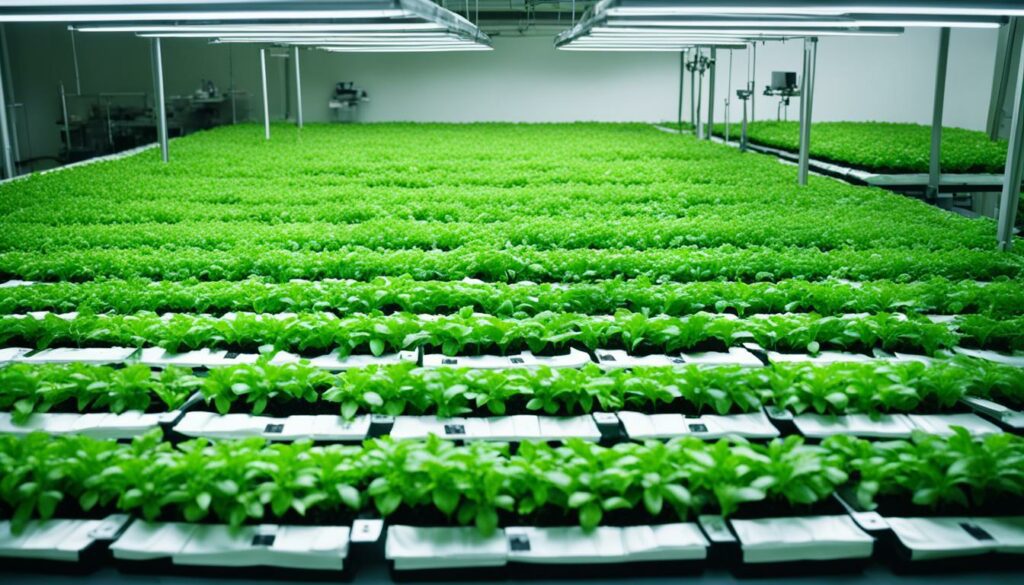
One big benefit of genetically modified crops is that they can boost productivity. In the US, many farmers have adopted these crops. This shows they are making a positive difference. For example, insect-resistant cotton has led to less use of chemical pesticides.
This reduces the harm to the environment and saves money. Studies have also shown that GM crops have helped improve the nutrients in food. They have done this by cutting down on the use of harmful chemicals.
Despite their benefits, genetically modified crops face challenges. Some people are unsure about them. They worry about how they might affect health and the environment.
There are also issues like the spread of altered genes and weeds becoming resistant to herbicides. It’s clear we need to address these challenges. This will require careful safety checks and getting everyone involved in the discussion.
Studies highlight the potential risks that come with these challenges. For example, herbicide-resistant weeds pose a problem. Guidelines from organisations like the European Food Safety Authority help ensure the use of GM crops is safe. They are aimed at making sure these crops benefit us all.
While there are challenges, the promising benefits of GM crops can’t be ignored. We need to manage the risks and involve the public in the conversation. This way, GM crops can be part of a sustainable farming future.
In biotech crop development, we’ve made big steps with advanced technology. I’ll highlight new techniques in agricultural biotechnology. These aim to increase crop yields, make crops more resilient, and help in sustainable farming.
Key methods include genome editing and nuclease technologies. These are vital in making crops better.
One of the top technologies is genome editing, like CRISPR-Cas. It allows precise changes in plant DNA to improve disease and stress resistance. Another key tool, site-directed nucleases, cuts DNA at precise spots. This allows for tweaking genes for specific benefits.
Using oligonucleotide-directed mutagenesis (ODM) is also crucial. It introduces mutations to specific sites. With these technologies, farmers get better crop performance and resilience.
Real examples show how effective these technologies are. The Philippine Rice Research Institute used CRISPR-Cas to make disease-resistant rice. In the US, corn, cotton, and soybeans from biotech crops were a big part of planting in 2012.
These cases show successful use of advanced agricultural technology. Biotechnology makes crops tougher and more productive. It helps in tackling food security issues by increasing the amount we can grow.
Genetically engineered plants have changed farming for the better. They have brought more food to our tables around the world. By using biotechnology, we’ve made plants that can fight off pests and tough weather. This has led to bigger crop harvests and a more sustainable future.
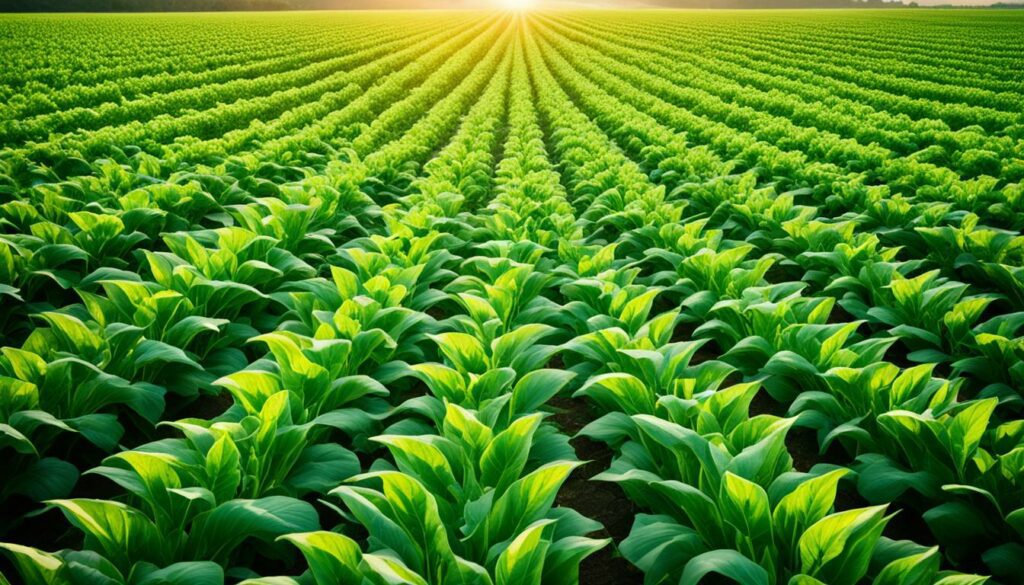
Many crops now yield more thanks to biotechnology. In the US, most corn, cotton, and soybeans come from these advanced crops. This was 88% of corn, 94% of cotton, and 93% of soybeans in 2012. Here are some successful types:
Genetically engineered plants have a huge impact on food production worldwide. The ISAAA found that in 2012, a big part of the world’s farm fields grew biotech crops. These achievements help not just with more food but also with keeping the environment sound.
These advanced crops give us more food, better food, and help the plants deal with many kinds of stress. The FDA and EPA check them for safety. They see if these crops make people sick from new proteins or cause allergies.
| Crop | Percentage of Biotechnology Plantings in 2012 |
|---|---|
| Corn | 88% |
| Cotton | 94% |
| Soybeans | 93% |
Sustainable farming means growing a lot of food without harming the earth. By using biotechnology, we’re helping farmers produce more food. This way, we can make sure everyone has enough good food to eat.
Biotech crops are great at cutting down the need for pesticides. In the US, by 2012, 88% of total corn plantings, 94% of cotton plantings, and 93% of soybean plantings were from biotechnology. This shows how important these crops are in farming today.
The USDA’s NASS looks at biotechnology plantings every year. They work with the USDA, EPA, and FDA to check the safety and effects of these crops. This ensures biotech crops are safe and helpful for farming.
One key plus of biotech crops is they cut down the use of chemical pesticides. They’ve managed to lower pesticide use by 37% on average. This helps reach farming goals that care for the environment. It means fewer harmful chemicals in our food and soil.
Here’s what you can get from GM crops compared to non-GM ones, based on reviews of 147 studies:
| Attribute | GM Crops | Non-GM Crops |
|---|---|---|
| Yield Increase | 22% | – |
| Pesticide Reduction | 37% | – |
| Farmer Profits | 68% | – |
Biotech crops not only help with pests and the environment. They also make it easier to control insects and weeds, improving how crops are protected. As technology gets better, the focus is on making crops that are more nutritious, and can handle tough environmental conditions. This makes farming better for the planet, aiming for sustainable and responsible practices.
New breeding innovations (NBIs) are changing the way we improve crop traits. They use advanced technologies like genome editing. Through these, breeders can tackle hard agricultural problems more easily. NBIs are set to make a big difference by 2050, when the world will need 50% more food.

One key technique in new breeding is genome editing. It allows precise changes in a plant’s genes. Tools like CRISPR-Cas help create crops that can survive harsh weather, pests, and diseases. This is great for making sure we have enough food and reducing gaps in crop yields.
Places like the U.S.A., Australia, and Japan are using NBIs to develop strong crop varieties. These varieties quickly move from the lab to fields as they don’t use transgenes. They boost food production by improving things like crop yield, tolerance to stress, and resistance to pests.
There are specific rules to guide the development and use of NBIs. These rules focus on the genetic changes themselves. They aim to make sure changes are safe for us and the environment. This approach helps balance innovation with safety.
Dr. Paul S. Teng says NBIs can help with all aspects of food security. For instance, with crops that stay fresh longer or have more nutrients. This can cut down on the 1.3 billion tons of wasted food each year. The rules also keep an eye on the advantages and issues of NBIs, making sure we use them well.
For more insight on how NBIs can boost food security, see ISAAA’s Brief 56. It’s a deep dive on the topic. Download the report via the ISAAA Inc. platform.
Animal biotechnology is changing the livestock world. By using genetic engineering, we can solve many challenges. This technology has brought us animals with stronger disease resistance and better growth. Important biotech regulation is in place to keep these advances safe and effective.
Genetic editing in animals has completely changed how we farm and breed them. A method called CRISPR/Cas9 has made it possible to edit animal genes accurately. For example, the AquaBounty salmon grows faster, and some livestock are made to resist diseases.
These techniques have had great success. For instance, the success rate when editing cattle embryos can be as high as over 90%.
So far, the AquaBounty salmon is the only genetically modified animal product on the market. After getting the green light from the U.S. and Brazilian authorities, it shows the promising future of this technology in farming.
The rules around genetically modified animals are crucial for their safe development and sale. Since 1986, the U.S. has had a strict set of rules for evaluating the safety of animal biotechnology products. The USDA-APHIS, EPA, and FDA work together to make sure these rules are followed.
The USDA-APHIS looks at the risks of using modern biotechnology and lets companies ask not to be regulated. The FDA checks that food from these animals is safe and labelled correctly. The EPA watches over the use of pest-killing substances in these animals.
Through Executive Order 14081, the U.S. is pushing for more innovation in biotechnology while keeping safety in mind. They want to encourage new, safe ideas that help everyone, including animals.
Biotech solutions have changed the game in protecting crops. They offer new ways to use less harmful chemicals. This addresses big agricultural issues. It’s all about using tech in farming to make it last and keep our planet safe.
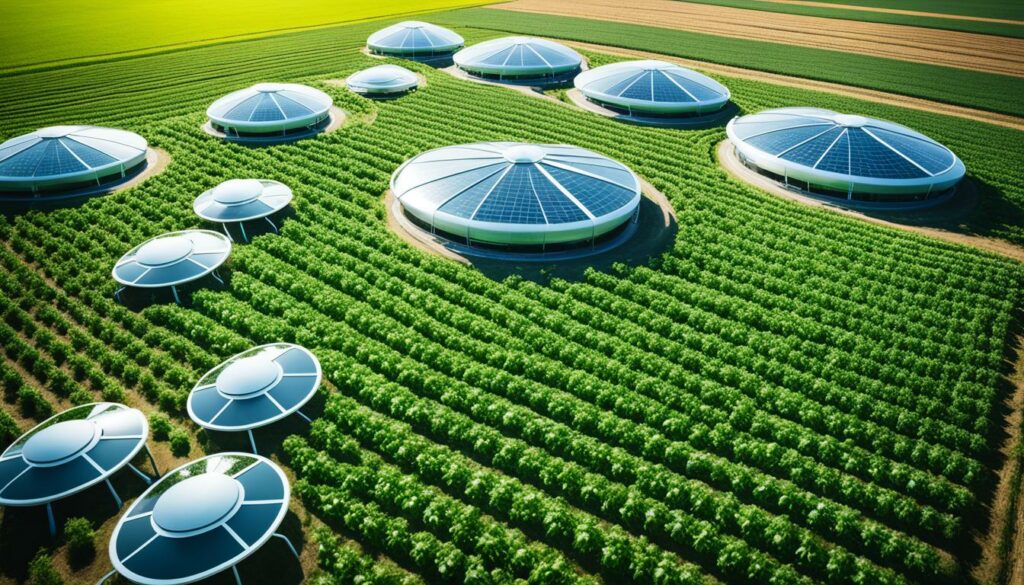
Biotech crops are big in the US. In 2012, most corn, cotton, and soybeans there were biotech. This shows how well biotech can help protect crops and improve how much we get from them.
There are two main types of crop protection from biotech. One is called vertical resistance and the other is horizontal resistance. Vertical’s about using a few genes to make crops less sensitive. This is done by things like backcrossing. Horizontal protection is more complex. It involves adding many genes. This helps crops resist a range of pests or herbicides.
Studying biotech shows us new potential for farming. For example, one study looked into using certain plant parts to fight weeds. Another big thing is using CRISPR to make soybeans that resist herbicides. These studies push for farming that lasts, doesn’t hurt the environment, and keeps crops strong.
Biotech has really moved agriculture forward. Every year, more farmers use biotech crops, says the USDA. These crops offer new ways to fight pests and diseases. In India, Bt cotton has shown how we can keep crops going despite bug problems.
We also need smart ways to stop weeds and handle biotech plants with care. Making rice that can handle weed killer better has improved how much rice we get. It also tastes better, showing more about biotech’s potential for good.
To really protect crops well, we need to know lots about genes and what we do with them. Mixing old and new ways of changing plants is key. This mix helps us farm in ways that are good for the land and us.
Genome editing, with CRISPR-Cas at its heart, is the cutting edge of crop genetics. This tech uses Cas endonuclease and sgRNA to make specific genetic changes in plants. It’s a big step in how we can improve crops, making biotech in farming better.
The CRISPR-Cas9 system is leading genetic changes in crops. It’s shown to work well in radish plants, changing at least 62% of their genes. This is a big advance, especially in radishes, which were not usually changed this way.
CRISPR-Cas9 can also be used in many ways. For example, in soybeans, it made crops better for us by lowering harmful sugars and raising healthy sugars. This shows how useful it can be for different crops.
The uses of genome editing in crops are huge and could change a lot. In maize, this tech has improved growth and how much food it makes. In barley, it fights a damaging virus without hurting the crop.
Wheat with fewer pests showed big changes in its genes. They started making more defence against bugs thanks to genome editing. Imagine how this could help reduce chemical use in farming.
| Statistical Data | Description |
|---|---|
| 62% editing efficiency | Achieved in radish plants using CRISPR-Cas9 |
| 25-30% crop yield losses | Due to aphid infestations |
| TCTU-tRNA system | Better editing efficiency in soybeans for CRISPR-Cas9-induced mutations |
These advances in tech could make creating new better crops cheaper. This could help make farming more sustainable and keep our food supply safe. We’re seeing old and new ways of improving crops work together.
It’s key to add new features, like bug-fighting traits, to crops. Using both old ways and genome editing together is the way forward. It helps improve crops and doesn’t harm the environment.
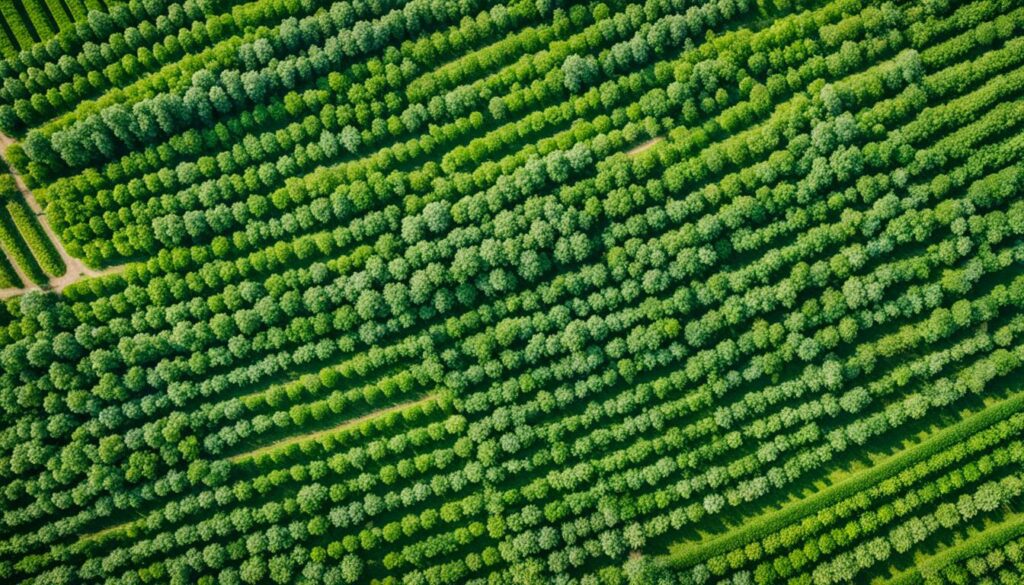
Biotechnology plays a key part in reaching sustainable crop production. It has brought biotech crops that boost agricultural productivity. These crops yield more, resist pests, and stand tough against the environment. This way, biotechnology pushes agriculture towards being more efficient and green.
The US has embraced genetically engineered crops a lot. In 2012, 88% of corn, 94% of cotton, and 93% of soybeans were biotech. This shows how much we rely on biotech for feeding our growing world.
Sustainable agriculture balances big harvests with caring for the environment and people. Here, sustainable agri-solutions shine. They use biotechnology to find new, clever ways to grow crops.
Using biofertilisers and biopesticides is a big change towards eco-friendly farming. These use of microorganisms helps plants grow better and keeps the soil rich. It shows how biotech can support lasting, greener farming.
ISAAA’s data shows the area of biotech crops is growing worldwide. This shows more and more farmers see the benefits. Also, the past work in biotechnology is as important for farming as the green revolution was.
Adding biotechnology to farming doesn’t just up crop yields. It also helps with food safety, makes food more nutritious, and saves nature. In all, it’s a solid plan for reaching truly green farming solutions.
In the world of biotechnology, getting a social license is key to selling biotech crops. It’s crucial to show the public and groups of interest that these crops are safe and trusted. This trust leads to people accepting and using these new technologies. By talking openly and involving everyone in the process, the biotech field can gain trust. It can also make sure its efforts match what society wants.
Gaining social trust in biotech needs clear talks and engaging with many groups. Places like Michigan State University hold courses with many participants, talking about important biotech issues each year. These talks help spread information and build understanding about biotech crops.
In Africa, biotech crops like Bt. cotton have been sold. Places in Asia have also seen crops like Bt. brinjal/eggplant shared. Such cases show the ongoing need to inform farmers and the public about biotech’s benefits to maintain their trust.
Making biotech crops a success involves a few steps. Addressing what the public worries about is first. For example, the StarLink maize issue showed that not doing this well can be risky. It’s why strong rules, like ETS guidelines, are vital for looking after biotech crops properly.
Also, getting the right checks and approvals is key. Projects like the late blight potato field trials and the awaiting approval for Golden Rice are important. Policymakers need to think about the money effects, like what happened with unapproved wheat types. Talking openly with people helps everyone understand the good and bad, which is important for making biotech crops do well.
By working together globally, there are big steps happening, like in China and in the U.S. with GalSafe™ pigs. It shows there’s a lot of support to make biotech innovations work. To move from development to everyday use, keeping up the social trust is very important.
Modern farming has changed a lot thanks to biotechnology. Now, with biotech enhancements, farmers can use sustainable farming techniques. This has made farming both more efficient and better for the environment.

Things like genomic editing and GMOs have really boosted how much food we produce. In 2012, most of the corn and cotton in the US was genetically modified. A lot of soybeans were too. These numbers show how much farmers depend on agri-biotech solutions.
The USDA provides details on how the use of genetically engineered crops is growing in the US. These crops are made to be better in quality, handle stress well, and give more produce.
Globally, we’re using biotech to meet food needs without harming the environment. The ISAAA said there was a big increase in biotech crop areas in 2012. This shows how important biotechnology is in farming today.
| Crop | Biotechnology Adoption Rate (2012) |
|---|---|
| Corn | 88% |
| Cotton | 94% |
| Soybeans | 93% |
In sum, mixing new farming methods with biotechnology helps us produce more food. It also keeps the planet healthier. This move to more advanced agri-biotech solutions promises a better future for feeding everyone.
The United States leads the way in biotech crop development worldwide. By 2012, about 88 percent of the U.S. corn, 94 percent of cotton, and 93 percent of soybeans were biotech crops. This shows the U.S.’s huge impact on the world’s agriculture.
The U.S. has a faster system for approving biotech crops, enabling quick growth. In the EU, regulations are stricter and slow the process down. The ISAAA found that the global biotech crop area grew from 179.7 million hectares in 2015 to 185.1 million hectares in 2016.
Few things affect the use of biotech crops, like new product acceptance and policies. In 2016, Brazil grew the most biotech crops by adding 4.9 million hectares. The USA and Canada came next.
Now, developing countries lead in planting biotech crops. Between 2012 and 2016, they grew more than industrial nations. In 2016, 54% of the world’s biotech crops were grown in developing countries. Brazil, Argentina, India, and China were top producers.
By 2017, the global adoption of GM crops reached 189.8 million hectares. They play a key role in ensuring food security and sustainable farming.
| Country | Increase in Biotech Crop Area (2016) |
|---|---|
| Brazil | 4.9 million hectares |
| USA | 2 million hectares |
| Canada | 600,000 hectares |
Many key health and science organisations say GM foods are as safe as traditional food. GM crops that resist insects can also help both plants and the health of people and animals.
Biotechnology plays a key role in boosting agriculture for a sustainable future. A recent study with opinions from 66 experts, mostly from Africa and Asia, shows hope. Sixteen new crop types are ready for the market.
These new plants have special traits, like being able to resist bugs, withstand weed killers, deal with lack of water, and offer more nutrients. This is the path for future farming.
The Excellence Through Stewardship (ETS) programme is making a big difference. It lays down good ways to use genetically changed crops. Such guidance is key, showing how to handle these crops well. This work by groups like the African Agricultural Technology Foundation proves they know what they’re doing.
Investing in biotech farming is an important step. It’s crucial for better food security, smarter use of resources, and improving farm work all over the world. These steps promise to handle future food challenges in a safe way, which is a big move towards better farming for everyone.
Sustainable agriculture meets our food needs without harming the earth. It links making money, protecting nature, and being fair to all.
Biotechnology helps by boosting crops, making them fight off bugs and diseases. It also can make food more nutritious. This supports both the environment and our future.
Genetically modified crops can grow better and have more nutrients. They also need fewer chemicals to grow well. This helps farming be more efficient and safe for the environment.
People may worry about GMO crops. It’s also important to share the good of GMOs fairly. And rules about using GMO crops must be followed closely.
CRISPR-Cas, Site-Directed Nucleases (SDNs), and Oligonucleotide-directed Mutagenesis (ODM) are major techs. They let scientists change crops in very specific ways to make them better.
Insect-resistant maize and herbicide-tolerant soybeans are some examples. They can grow more food and survive better against nature’s challenges.
Crops that can resist pests mean less need for chemicals. This helps the environment and makes farming more sustainable.
CRISPR-Cas and gene editing are new ways to make crops better. They allow for very precise changes to crops, helping them grow stronger and produce more.
Rules on animal biotech focus on progress and animal care. They make sure biotech animals are safe and their use is fair and properly controlled.
To protect crops, there are biotech seeds and eco-friendly pesticides. These methods support farming that’s good for the planet and needs less harmful chemicals.
Genome editing can make crops grow better, protect them from diseases, and improve what’s in our food. It could change farming a lot, making it more productive and safe.
Biotech, along with smart and careful farming, helps use resources better. This saves the environment and makes farming more sustainable and strong.
A social licence means people trust and support biotech crops. It takes talking to everyone, and being open and honest about what’s being done.
Rules about biotech crops vary around the world. The US has seen a lot of progress, but the EU’s rules have slowed things down.